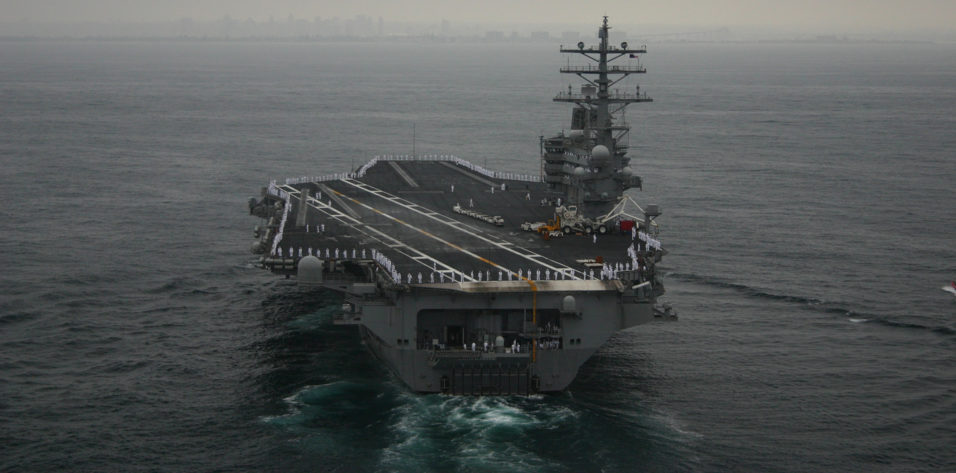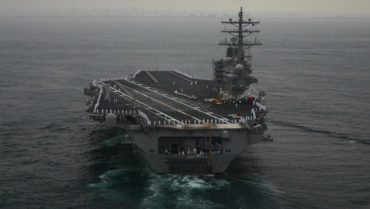
If you want to witness a lively debate, ask a few naval military historians to discuss why battleships are no longer produced. Opinions vary widely on why these behemoths of the sea, with their crews of thousands, have vanished from modern naval arsenals. Most explanations revolve around the problem of concentrating so many resources on a single ship and in the face of nimble and powerful threats such as aircraft, long-range missiles, and torpedoes.1,2 Others point to the rise of the aircraft carrier as the capital ship of the fleet to project naval power.3 Modern aircraft carriers typically deploy with a group of smaller supporting ships that the US Navy calls carrier strike groups.4
Today, a new debate is brewing regarding the long-term viability of aircraft carriers. Hypersonic missiles and other threats have sparked discussion of whether navies should fight as an aggregated force centered on a large carrier or as a more distributed force with many smaller ships.1,5 The vulnerability of a single concentrated asset is easy to understand, but the power of these aircraft carrier strike groups is undeniable.
Who would have imagined that the sheer size and scope of our largest ophthalmology meetings would also become a vulnerability? These large meetings are immensely valuable to our profession. No other forum draws the same concentration of physicians, industry representatives, equipment, wet labs, scientists, members of the financial community, and media in a single location. But like an aircraft carrier, our largest meetings also offer the added benefit of many smaller supporting meetings that occur in their orbit. These include industry meetings, advisory boards, users’ groups, and myriad other events that take advantage of the convergence of so many constituents in the ophthalmology world. Having this entire ecosystem disrupted by a pandemic was not on my radar.
In mid-May, the ASCRS hosted a virtual version of its annual meeting. The participants are to be congratulated for accomplishing the herculean task of converting the meeting to an online format. The 2020 ASCRS Virtual Annual Meeting was well run, productive, and educational. Given the circumstances, it was hard for me to imagine an organization doing a better job than ASCRS did with this meeting.
Two weeks later, BMC hosted its first virtual meeting, the BMC Virtual Spring Symposium. Once again, I was impressed by the execution and content that could be delivered to attendees during a virtual meeting.
Certainly, these two meetings have set new standards for the level of online content available at an ophthalmology meeting. This will probably carry over to future meetings even when live participation is possible. The demand for online educational content has been increasing for years, but this pandemic has accelerated that trend. A virtual format is much more convenient and affordable, increasing the number of physicians who can access the content.
But a virtual version of a meeting is not the same as the real thing. Prerecording my lectures and fielding a few questions via video chat lacked the energy of a live meeting, at least for me. I had no way to judge whether I was connecting with the audience or boring them. I enjoyed several of the talks I viewed, but something was missing. The casual interactions with colleagues, which often produce the best pearls I learn all year, were absent.
The global ophthalmic community we have all grown to value so much over the years was present, but not really. I suspect that small meetings will grow in popularity because of COVID-19, and I truly don’t know when the next large ophthalmology meeting will occur. But assuming prevailing conditions allow it, I will be there.
Steven J. Dell, MD | Chief Medical Editor
1. McIntyre J. Too big to sail? US aircraft carriers could go the way of the dinosaur. Washington Examiner. December 4, 2018. https://www.washingtonexaminer.com/policy/defense-national-security/too-big-to-sail-us-aircraft-carriers-could-go-the-way-of-the-dinosaur. Accessed May 21, 2020.
2. O’Connell RL. Sacred vessels: the cult of the battleship and the rise of the U.S. Navy. Oxford [Oxfordshire]: Oxford University Press; 1993.
3. Collett JA. The aircraft carrier – The backbone of aero-sea warfare. Proceedings. 1942;68(478).
4. The carrier strike group. United States Navy. www.navy.mil/navydata/ships/carriers/powerhouse/cvbg.asp. Accessed May 21, 2020.
5. Larter DB. With China gunning for aircraft carriers, US Navy says it has to change how it fights. Business Insider. December 19, 2019. www.businessinsider.com/navy-must-change-how-it-fights-amid-aircraft-carrier-threats-2019-12. Accessed May 21, 2020.




